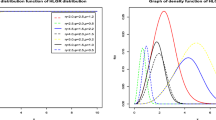Abstract
We present a new family of copulas—the Singular Mixture Copulas. We begin with constructing singular copulas whose supports lie on the graphs of two given quantile functions. These copulas are then mixed with respect to a continuous distribution resulting in a nonsingular parametric copula.
The Singular Mixture Copulas we construct have a Lebesgue density and a closed form representation. Moreover, they have positive lower and upper tail dependence. As an application we fit the copulas to flood level data. As the results show Singular Mixture Copulas provide an alternative to elliptical copulas, e.g., Gaussian and t-copulas, in modeling strongly dependent random variables.
Zusammenfassung
Ausgehend von einer unendlichen Familie von singulären Copulas, d.h. Copulas, die keine Lebesgue-Dichte besitzen, wird durch Bildung konvexer Summen eine parametrische Copula-Familie konstruiert. Die neukonstruierten Copulas, die Singular Mixture Copulas, besitzen viele wünschenswerte mathe-matische Eigenschaften: Sie sind stetig, besitzen eine Lebesgue-Dichte, sowie positive untere und obere Tail-Abhängigkeiten und darüber hinaus eine explizite Darstellung. Des Weiteren existiert ein einfacher Algorithmus, um aus diesen Verteilungen zu simulieren.
Als nicht-elliptische Copulas stellen die Singular Mixture Copulas eine Alternative zu t- und Gauß-Copulas bei der Modellierung stark abhängiger Einflussgrößen dar. Als Anwendung wird eine Singular Mixture Copula an einen realen Datensatz von Nordsee-Pegelständen angepasst und ihre Anpassungsgüte mittels eines Tests überprüft. Insbesondere für die Modellierung von und Absicherung vor Sturmfluten bieten die Singular Mixture Copulas eine gute Alternative, da sie sehr starke Tail-Abhängigkeiten produzieren.





Similar content being viewed by others
Notes
The factor 4 results from empirical experiences.
References
Berg, D.: Copula goodness-of-fit testing: an overview and power comparison. Eur. J. Finance 15, 675–701 (2009)
Cherubini, U., Luciano, E., Vecchiato, W.: Copula Methods in Finance. Wiley & Sons, Chichester (2004)
Embrechts, P., Lindskog, F., McNeil, A.J.: Modelling dependence with copulas and applications to risk management. In: Rachev, S.T. (ed.) Handbook of Heavy Tailed Distributions in Finance, pp. 329–384. Elsevier, Amsterdam (2003)
Genest, C., MacKay, R.: The joy of copulas: bivariate distributions with uniform marginals. Am. Stat. 40(4), 280–283 (1986)
Genest, C., Rémillard, B., Beaudoin, D.: Goodness-of-fit tests for copulas: a review and a power study. Insur. Math. Econ. 44, 199–213 (2009)
Joe, H.: Multivariate Models and Dependence Concepts. Chapman & Hall, London (1997)
McNeil, A.J., Frey, R., Embrechts, P.: Quantitative Risk Management: Concepts, Techniques and Tools. Princeton University Press, Princeton (2005)
Nelsen, R.B.: An Introduction to Copulas. Springer, New York (2006)
Author information
Authors and Affiliations
Corresponding author
Rights and permissions
About this article
Cite this article
Lauterbach, D. Singular mixture copulas. ZVersWiss 101, 605–619 (2012). https://doi.org/10.1007/s12297-012-0198-y
Published:
Issue Date:
DOI: https://doi.org/10.1007/s12297-012-0198-y




